|

by
F. William Engdahl
August 23, 2012
from
VoltaireNet Website
Spanish version
With little fanfare
Barack Obama late last year announced a "strategic
pivot" in U.S. defense policy to focus on the Pacific,
bolstered by "Coalition of the willing" Australia.
It is all about emerging
China as an economic colossus with a mind all its own.
The U.S. military has been steadily positioning itself
along the strategic sea lanes surrounding China to deal
potentially deadly blows to the mainland as well as
cutting off its oil corridors to the Middle East and
Africa.
This author breaks down a
situation where the noose tightening around China could
generate a major new conflict zone in the not too
distant future.
Part I
Pentagon Targets China
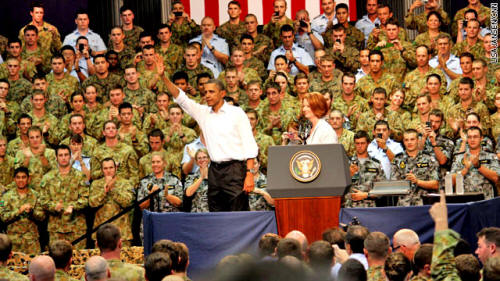
Since the collapse of the Soviet Union and the
nominal end of the Cold War some twenty years back, rather than reducing the
size of its mammoth defense spending, the U.S. Congress and all U.S. Presidents
have enormously expanded spending for new weapons systems, increased
permanent military bases around the world and expansion of NATO not only to
former Warsaw Pact countries on Russia's immediate periphery.
It also has expanded NATO and U.S. military
presence deep into Asia on the perimeters of China through its conduct of
the Afghan war and related campaigns.
On the basis of simple dollar outlays for military spending, the
U.S. Pentagon
combined budget, leaving aside the huge budgets for such national security
and defense-related agencies of U.S. Government as the Department of Energy
and U.S. Treasury and other agencies, the U.S. Department of Defense spent some
$739 billion in 2011 on its military requirements.
Were all other spending that is tied to
U.S.
defense and national security included, the London-based International
Institute for Strategic Studies estimates an annual military spending of
over $1 trillion by the United States.
That is an amount greater than the total
defense-related spending of the next 42 nations combined, and more than the
Gross Domestic Product of most nations.
China officially spent barely 10% of the
U.S. outlay on its defense, some $90
billions, or, if certain defense-related arms import and other costs are
included, perhaps $111 billion a year.
Even if the Chinese authorities do not publish
complete data on such sensitive areas, it is clear China spends a mere
fraction of the USA and is starting from a military-technology base far
behind the USA.
China today, because of its dynamic economic growth and its determination to
pursue sovereign Chinese national interests, merely because China exists, is
becoming the Pentagon new "enemy image," now replacing the earlier "enemy
image" of Islam used after September 2001 by the Bush-Cheney Administration
to justify the Pentagon's global power pursuit, or that of Soviet Communism
during the Cold War.
The new U.S. military posture against China has
nothing to do with any aggressive threat from the side of China.
The Pentagon has decided to escalate its
aggressive military posture to China merely because China has become a
strong vibrant independent pole in world economics and geopolitics.
Only
vassal states need apply to Washington's globalized world.
Obama Doctrine - China
is the new 'enemy image'
After almost two decades of neglect of its interests in East Asia, in 2011,
the Obama Administration announced that the U.S. would make "a strategic
pivot" in its foreign policy to focus its military and political attention
on the Asia-Pacific, particularly Southeast Asia, that is, China.
The term "strategic pivot" is a page out of the
classic textbook from the father of British geopolitics, Sir Halford
Mackinder [1], who spoke at various times of Russia and later
China as "pivot powers" whose geographical and geopolitical position posed
unique challenges to Anglo-Saxon and after 1945, to American hegemony.
During the final months of 2011 the Obama Administration clearly defined a
new public military threat doctrine for U.S. military readiness in the wake of
the U.S. military failures in Iraq and Afghanistan.
During a Presidential trip
to the Far East, while in Australia, the U.S. President unveiled what is being
termed the Obama Doctrine. [2]
Obama told the Australians then:
With most of the world's nuclear power and
some half of humanity, Asia will largely define whether the century
ahead will be marked by conflict or cooperation…
As President, I have,
therefore, made a deliberate and strategic decision - as a Pacific
nation, the United States will play a larger and long-term role in
shaping this region and its future…
I have directed my national security team to
make our presence and mission in the Asia Pacific a top priority...
As we plan and budget for the future, we
will allocate the resources necessary to maintain our strong military
presence in this region. We will preserve our unique ability to project
power and deter threats to peace…Our enduring interests in the region
demand our enduring presence in the region.
The United States is a Pacific power, and we are here to stay. Indeed,
we are already modernizing America's defense posture across the Asia
Pacific. It will be more broadly distributed - maintaining our strong
presence in Japan and the Korean Peninsula, while enhancing our presence
in Southeast Asia. Our posture will be more flexible - with new
capabilities to ensure that our forces can operate freely...
I believe we can address shared challenges,
such as proliferation and maritime security, including cooperation in
the South China Sea. [3]
The centerpiece of Obama's visit was the
announcement that at least 2,500 elite U.S. Marines will be stationed in
Darwin in Australia's Northern Territory.
In addition, in a series of significant parallel
agreements, discussions with Washington were underway to fly long-range
American surveillance drones from the remote Cocos Islands - an Australian
territory in the Indian Ocean.
Also the U.S. will gain greater use of Australian
Air Force bases for American aircraft and increased ship and submarine
visits to the Indian Ocean through a naval base outside Perth, on the
country's west coast.
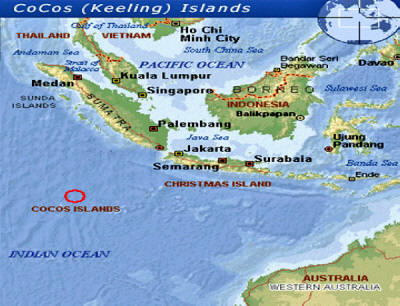
Cocos Island
U.S. Base to control Indian Ocean
The Pentagon's target
is China
To make the point clear to European members of NATO, in remarks to fellow
NATO members in Washington in July 2012, Phillip Hammond, the UK Secretary
of State for Defense declared explicitly that the new U.S. defense shift to
the Asia-Pacific region was aimed squarely at China.
Hammond said that,
"the rising strategic importance of the
Asia-Pacific region requires all countries, but particularly the United
States, to reflect in their strategic posture the emergence of China as
a global power. Far from being concerned about the tilt to Asia-Pacific,
the European NATO powers should welcome the fact that the U.S. is willing
to engage in this new strategic challenge on behalf of the alliance."
[4]
As with many of its operations, the Pentagon
deployment is far deeper than the relatively small number of 2,500 new U.S.
soldiers might suggest.
In August 2011 the Pentagon presented its annual report on China's military.
It stated that China had closed key technological gaps.
Deputy Assistant
Secretary of Defence for East Asia, Michael Schiffer, said that the
pace and scope of China's military investments had,
"allowed China to pursue capabilities that
we believe are potentially destabilizing to regional military balances,
increase the risk of misunderstanding and miscalculation and may
contribute to regional tensions and anxieties." [5]
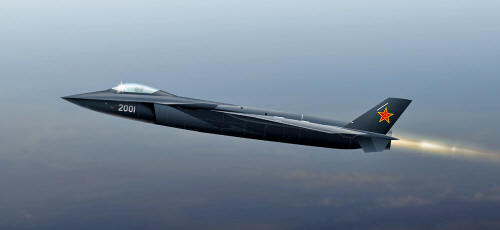
Washington think tank, The Jamestown Foundation,
calls the J20 plane a "game
changer,"
that will render all
air defense in the region obsolete.
He cited Chinese refurbishing of a Soviet-era aircraft carrier and China's
development of its J20 Stealth Fighter as indications of the new capability
requiring a more active U.S. military response.
Schiffer also cited China's space and cyber
operations, saying it was,
"developing a multi-dimensional program to
improve its capabilities to limit or prevent the use of space-based
assets by adversaries during times of crisis or conflict." [6]
PART II
Pentagon's
'Air-Sea Battle'
The Pentagon strategy to
defeat China in a coming war, details of which have filtered into
the U.S. press, is called "Air-Sea Battle."
This calls for an aggressive coordinated
U.S.
attack. U.S. stealth bombers and submarines would knock out China's long-range
surveillance radar and precision missile systems deep inside the country.
This initial "blinding campaign" would be followed by a larger air and naval
assault on China itself. [7]
Crucial to the advanced Pentagon strategy,
deployment of which has already quietly begun, is U.S. military navy and air
presence in Japan, Taiwan, Philippines, Vietnam and across the South China
Sea and Indian Ocean. Australian troop and naval deployment is aimed at
accessing the strategic Chinese South China Sea as well as the Indian Ocean.
The stated motive is to "protect freedom of navigation" in the Malacca
Straits and the South China Sea.
In reality it is to be positioned to cut China's
strategic oil routes in event of full conflict.
Air-Sea Battle's goal is to help
U.S. forces withstand an initial Chinese
assault and counterattack to destroy sophisticated Chinese radar and missile
systems built to keep U.S. ships away from China's coastline. [8]
U.S. 'Air-Sea Battle'
against China
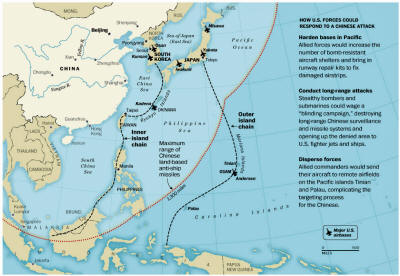
Pentagon 'China Blinding' Air Sea Attack Strategy
In addition to the stationing of the
U.S. Marines in the north of Australia,
Washington plans to fly long-range American surveillance drones from the
remote Cocos Islands - an Australian territory in the strategically vital
Indian Ocean.
Also it will have use of Australian Air Force
bases for American military aircraft and increased ship and submarine visits
to the Indian Ocean through a naval base outside Perth, on Australia's west
coast. [9]
The architect of the Pentagon anti-China strategy of Air-Sea battle is
Andrew Marshall, the man who has shaped Pentagon advanced warfare strategy
for more than 40 years and among whose pupils were Dick Cheney and Donald
Rumsfeld. [10]
Since the 1980s Marshall has been a promoter of
an idea first posited in 1982 by Marshal Nikolai Ogarkov, then chief of the
Soviet general staff, called RMA, or 'Revolution in Military Affairs.'
Marshall, today at the ripe age of 91, still holds his desk and evidently
very much influence inside the Pentagon.
The best definition of RMA was the one provided by Marshall himself:
"A Revolution in Military Affairs (RMA)
is a major change in the nature of warfare brought about by the
innovative application of new technologies which, combined with
dramatic changes in military doctrine and operational and
organizational concepts, fundamentally alters the character and
conduct of military operations."
[11]
It was also Andrew Marshall who convinced
U.S.
Defense Secretary Donald Rumsfeld and his successor Robert Gates
to deploy the Ballistic Missile "defense" Shield in,
-
Poland
-
the Czech
Republic
-
Turkey
-
Japan,
...as a strategy to minimize any potential nuclear
threat from Russia and, in the case of Japan's BMD, any potential nuclear
threat from China.
PART III
'String of Pearls' Strategy of Pentagon
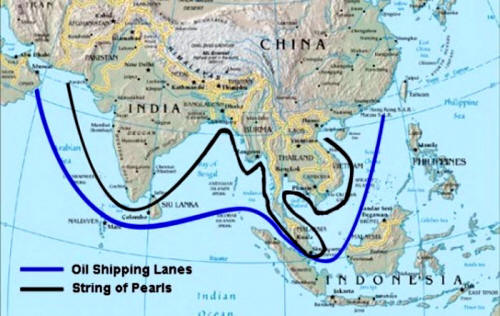
Pentagon String of Pearls Strategy to block China Oil Shipping Lanes.
In January 2005, Andrew Marshall
issued a classified internal report to Defense Secretary Donald
Rumsfeld titled "Energy Futures in Asia."
The Marshall report, which was leaked in full to
a Washington newspaper, invented the term "string of pearls" strategy to
describe what it called the growing Chinese military threat to "U.S. strategic
interests" in the Asian space. [12]
The internal Pentagon report claimed that,
"China is building strategic
relationships along the sea lanes from the Middle East to the South China
Sea in ways that suggest defensive and offensive positioning to protect
China's energy interests, but also to serve broad security objectives."

91 year-old Andrew Marshall
In the Pentagon Andrew Marshall report, the term China's
"String of Pearls"
Strategy was used for the first time.
It is a Pentagon term and not a
Chinese term.
The report stated that China was adopting a "string of pearls"
* strategy of
bases and diplomatic ties stretching from the Middle East to southern China
that includes a new naval base under construction at the Pakistani port of Gwadar.
* The phrase "string of pearls"
was first used to describe China's emerging maritime strategy in a
report titled "Energy Futures in Asia" by defense contractor,
Booz-Allen-Hamilton, which was commissioned in 2005 by the U.S.
Department of Defense's Office of Net Assessment.
It claimed that,
"Beijing already has set up electronic
eavesdropping posts at Gwadar in the country's southwest corner, the
part nearest the Persian Gulf. The post is monitoring ship
traffic through the Strait of Hormuz and the Arabian Sea." [13]
The Marshall internal report went on to warn of
other "pearls" in the sea-lane strategy of China:
-
Bangladesh:
China is strengthening its ties to the
government and building a container port facility at Chittagong. The
Chinese are "seeking much more extensive naval and commercial
access" in Bangladesh.
-
Burma:
China has developed close ties to the
military regime in Rangoon and turned a nation wary of China into a
"satellite" of Beijing close to the Strait of Malacca, through which
80 percent of China's imported oil passes.
China is building naval
bases in Burma and has electronic intelligence gathering facilities
on islands in the Bay of Bengal and near the Strait of Malacca.
Beijing also supplied Burma with
"billions of dollars in military
assistance to support a de facto military alliance," the report
said.
-
Cambodia:
China signed a military agreement in
November 2003 to provide training and equipment. Cambodia is helping
Beijing build a railway line from southern China to the sea.
-
South China Sea:
Chinese activities in the region are
less about territorial claims than "protecting or denying the
transit of tankers through the South China Sea," the report said.
China also is building up its military forces in the region to be
able to "project air and sea power" from the mainland and Hainan
Island.
China recently upgraded a military airstrip on Woody Island
and increased its presence through oil drilling platforms and ocean
survey ships.
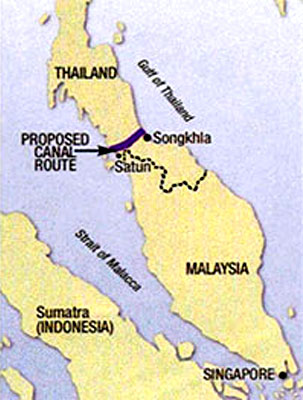
Proposed Kra Canal route
-
Thailand:
China is considering funding
construction of a $20 billion canal across the Kra Isthmus that
would allow ships to bypass the Strait of Malacca.
The canal project
would give China port facilities, warehouses and other
infrastructure in Thailand aimed at enhancing Chinese influence in
the region, the report said…
The U.S. military's
Southern Command produced a similar classified report in the
late 1990s that warned that China was seeking to use
commercial port facilities around the world to control
strategic "chokepoints." [14]
Breaking the String of
Pearls
Significant Pentagon and
U.S. actions since that 2005 report have been aimed
to counter China's attempts to defend its energy security via that "String
of Pearls."
The U.S. interventions since 2007 into
Burma/Myanmar have had two phases.
The first was the so-called Saffron Revolution, a
U.S. State Department and
CIA-backed destabilization in 2007 aimed at putting the international
spotlight on the Myanmar military dictatorship's human rights practices. The
aim was to further isolate the strategically located country internationally
from all economic relations, aside from China.
The background to the U.S. actions was China's
construction of oil and gas pipelines from Kunming in China's southwest
Yunnan Province, across the old Burma Road across Myanmar to the Bay of
Bengal across from India and Bangladesh in the northern Indian Ocean.
Forcing Burma's military leaders into tighter dependency on China was one of
the factors triggering the decision of the Myanmar military to open up
economically to the West.
They declared that the tightening of
U.S.
economic sanctions had done the country great harm and President Thein Sein
made his major liberalization opening, as well as allowing U.S.-backed
dissident, Aung San Suu Kyi, to be free and to run for elective office with
her party, in return for promises from U.S. Secretary of State Hillary Clinton
of U.S. investment in the country and possible easing of U.S. economic
sanctions. [15]
The U.S. corporations approaching Burma are hand-picked by Washington to
introduce the most destructive "free market" reforms that will open Myanmar
to instability.
The United States will not allow investment in entities
owned by Myanmar's armed forces or its Ministry of Defense.
It also is able to place sanctions on,
"those who undermine
the reform process, engage in human rights abuses, contribute to
ethnic conflict or participate in military trade with North
Korea."
The
United States will block businesses or individuals from making transactions
with any "specially designated nationals" or businesses that they control -
allowing Washington, for example, to stop money from flowing to
groups "disrupting the reform process."
It's the classic "carrot and stick" approach,
dangling the carrot of untold riches if Burma opens its economy to U.S.
corporations and punishing those who try to resist the takeover of the
country's prize assets. Oil and gas, vital to China, will be a special
target of U.S. intervention.
American companies and people will be allowed to
invest in the state-owned Myanma Oil and Gas Enterprise. [16]
Obama also created a new power for the government to impose "blocking
sanctions" on any individual threatening peace in Myanmar. Businesses with
more than $500,000 in investment in the country will need to file an annual
report with the State Department, with details on workers' rights, land
acquisitions and any payments of more than $10,000 to government entities,
including Myanmar's state-owned enterprises.
American companies and people will be allowed to invest in the state-owned
Myanma Oil and Gas Enterprise, but any investors will need to notify the
State Department within 60 days.
As well, U.S. "human rights" NGOs, many closely associated with or believed to
be associated with U.S. State Department geopolitical designs, including,
...will now be allowed to operate inside Myanmar
according to a decision by State Secretary Clinton in April 2012. [17]
Thailand, another key in China's defensive String of Pearl Strategy has also
been subject of intense destabilization over the past several years. Now
with the sister of a corrupt former Prime Minister in office, U.S.-Thai
relations have significantly improved.
After months of bloody clashes, the
U.S.-backed billionaire, Former Thai Prime
Minister Thaksin Shinawatra , managed to buy the way to put his sister,
Yingluck Shinawatra in as Prime Minister, with him reportedly pulling the
policy strings from abroad. Thaksin himself was enjoying comfortable status
in the U.S. as of this writing, in summer 2012.
U.S. relations with Thaksin's sister, Yingluck Shinawatra, are moving in
direct fulfillment of the Obama "strategic pivot" to focus on the "China
threat."
In June 2012, General Martin E. Dempsey,
chairman of the U.S. Joint Chiefs of Staff, after returning from a visit this
month to Thailand, the Philippines and Singapore stated:
"We want to be out
there partnered with nations and have a rotational presence that
would allow us to build up common capabilities for common
interests."
This is precisely key beads in what the Pentagon
calls the String of Pearls.
The Pentagon is now quietly negotiating to return to bases abandoned after
the Vietnam War. It is negotiating with the Thai government to create a new
"disaster relief" hub at the Royal Thai Navy Air Field at U-Tapao, 90 miles
south of Bangkok. The U.S. military built the two mile long runway there, one
of Asia's longest, in the 1960s as a major staging and refueling base during
the Vietnam War.
The Pentagon is also working to secure more rights to
U.S. Navy visits to Thai
ports and joint surveillance flights to monitor trade routes and military
movements.
The U.S. Navy will soon base four of its newest
warships - Littoral Combat Ships - in Singapore and would rotate them
periodically to Thailand and other southeast Asian countries. The Navy is
pursuing options to conduct joint airborne surveillance missions from
Thailand. [18]
In addition, Deputy Defense Secretary Ashton Carter went to Thailand in July
2012 and the Thai government has invited Defense Secretary Leon Panetta, who
met with the Thai minister of defense at a conference in Singapore in June.
[19]
In 2014, the U.S. Navy is scheduled to begin deploying new P-8A Poseidon
reconnaissance and anti-submarine aircraft to the Pacific, replacing the
P-3C Orion surveillance planes.
The Navy is also preparing to deploy new
high-altitude surveillance drones to the Asia-Pacific region around the same
time. [20]
PART IV
India-U.S. Defense 'Look
East Policy'
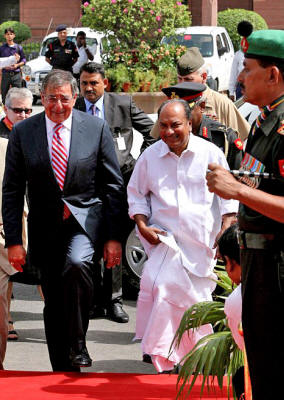
U.S. Defence Secretary Leon Panetta
walks with his Indian
counterpart A K Antony in New Delhi, 6 June 2012.
U.S. Secretary of Defense Leon Panetta was in India in June of this year where
he proclaimed that defence cooperation with India is the lynchpin of U.S.
security strategy in Asia.
He pledged to help develop India's military
capabilities and to engage with India in joint production of defence
"articles" of high technology.
Panetta was the fifth Obama Cabinet secretary to
visit India this year. The message that they have all brought is that, for
the U.S., India will be the major relationship of the 21st century.
The reason is China's emergence. [21]
Several years ago during the Bush Administration, Washington made a major
move to lock India in as a military ally of the U.S. against the emerging
Chinese presence in Asia. India calls it India's "Look East Policy."
In
reality, despite all claims to the contrary, it is a "look at China"
military policy.
In comments in August 2012, Deputy Secretary of defense
Ashton Carter
stated,
"India is also key part of our rebalance to
the Asia-Pacific, and, we believe, to the broader security and
prosperity of the 21st century. The U.S.-India relationship is global in
scope, like the reach and influence of both countries." [22]
In 2011, the U.S. military conducted more than 50
significant military activities with India.
Carter continued in remarks following a trip to New Delhi,
"Our security interests converge: on
maritime security, across the Indian Ocean region; in Afghanistan, where
India has done so much for economic development and the Afghan security
forces; and on broader regional issues, where we share long-term
interests.
I went to India at
the request of Secretary Panetta and with a high-level
delegation of U S technical and policy experts." [23]
Indian Ocean
The Pentagon "String of pearls" strategy against China in effect is not one
of beautiful pearls, but a hangman's noose around the perimeter of China,
designed in the event of major conflict to completely cut China off from its
access to vital raw materials, most especially oil from the Persian Gulf and
Africa.
Former Pentagon adviser Robert D. Kaplan, now with
Stratfor, has
noted that the Indian Ocean is becoming the world's "strategic center of
gravity" and who controls that center, controls Eurasia, including China.
The Ocean is the vital waterway passage for
energy and trade flows between the Middle East and China and Far Eastern
countries. More strategically, it is the heart of a developing south-south
economic axis between China and Africa and Latin America.
Since 1997 trade between China and Africa has risen more than twenty-fold
and trade with Latin America, including Brazil, has risen fourteen fold in
only ten years. This dynamic, if allowed to continue, will eclipse the
economic size of the European Union as well as the declining North American
industrial economies in less than a decade.
That is a development that
Washington circles and Wall Street are determined to prevent at all costs.
Straddled by the Islamic Arch - which stretches from Somalia to Indonesia,
passing through the countries of the Gulf and Central Asia - the region
surrounding the Indian Ocean has certainly become the world's new strategic
center of gravity. [24]
No rival economic bloc can be allowed to
challenge American hegemony.
Former Obama geopolitical adviser
Zbigniew Brzezinski, a student of Mackinder geopolitics and
still today along with
Henry Kissinger one of the most
influential persons in the U.S. power establishment, summed up the position as
seen from Washington in his 1997 book,
The Grand Chessboard - American
Primacy and its Geostrategic Imperatives:
It is imperative that no Eurasian challenger
emerges, capable of dominating Eurasia and thus of also challenging
America. The formulation of a comprehensive and integrated Eurasian
geo-strategy is therefore the purpose of this book. [25]
For America, the chief geopolitical prize is Eurasia… America's global
primacy is directly dependent on how long and how effectively its
preponderance on the Eurasian continent is sustained. [26]
In that context, how America 'manages' Eurasia is critical. Eurasia is
the globe's largest continent and is geopolitically axial. A power that
dominates Eurasia would control two of the world's three most advanced
and economically productive regions.
A mere glance at the map also suggests that
control over Eurasia would almost automatically entail Africa's
subordination, rendering the Western Hemisphere and Oceania
geopolitically peripheral to the world's central continent.
About 75 per cent of the world's people live
in Eurasia, and most of the world's physical wealth is there as well,
both in its enterprises and underneath its soil. Eurasia accounts for 60
per cent of the world's GNP and about three-fourths of the world's known
energy resources. [27]
The Indian Ocean is crowned by what some call an
Islamic Arch of countries stretching from East Africa to Indonesia by way of
the Persian Gulf countries and Central Asia.
The emergence of China and other much smaller
Asian powers over the past two decades since the end of the Cold war has
challenged U.S. hegemony over the Indian Ocean for the first time since the
beginning of the Cold War.
Especially in the past years as American
economic influence has precipitously declined globally and that of China has
risen spectacularly, the Pentagon has begun to rethink its strategic
presence in the Indian Ocean. The Obama 'Asian Pivot' is centered on
asserting decisive Pentagon control over the sea lanes of the Indian Ocean
and the waters of the South China Sea.
The U.S. military base at Okinawa, Japan is being rebuilt as a major center to
project U.S. military power towards China.
As of 2010 there were over 35,000 U.S. military
personnel stationed in Japan and another 5,500 American civilians employed
there by the United States Department of Defense. The United States Seventh
Fleet is based in Yokosuka. The 3rd Marine Expeditionary Force in Okinawa.
130 USAF fighters are stationed in the Misawa Air Base and Kadena Air Base.
The Japanese government in 2011 began an armament program designed to
counter the perceived growing Chinese threat. The Japanese command has urged
their leaders to petition the United States to allow the sale of F-22A
Raptor fighter jets, currently illegal under U.S law. South Korean and
American military have deepened their strategic alliance and over 45,000
American soldiers are now stationed in South Korea.
The South Koreans and Americans claim this is
due to the North Korean military's modernization. China and North Korea
denounce it as needlessly provocative. [28]
Under the cover of the
U.S. war on Terrorism, the U.S. has developed major
military agreements with the Philippines as well as with Indonesia's army.
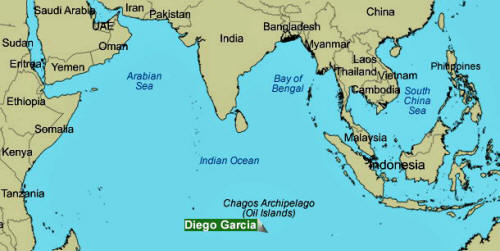
The military base on Diego Garcia is the lynchpin of
U.S. control over the
Indian Ocean.
In 1971 the U.S. military depopulated the citizens
of Diego Garcia to build a major military installation there to carry out
missions against Iraq and Afghanistan.
China has two Achilles heels,
Some 20% of China oil
passes through the Straits of Hormuz. And some 80% of Chinese oil imports
pass through the Strait of Malacca as well as major freight trade.
To prevent China from emerging successfully as the major economic competitor
of the United States in the world, Washington launched the so-called Arab
Spring in late 2010.
While the aspirations of millions of ordinary
Arab citizens in Tunisia, Libya, Egypt and elsewhere for freedom and
democracy was real, they were in effect used as unwitting cannon fodder to
unleash a U.S. strategy of chaos and intra-islamic wars and conflicts across
the entire oil-rich Islamic world
from Libya in North Africa
across to Syria
and ultimately
Iran in the Middle East. [29]
The
U.S. strategy within the Islamic Arch countries straddling the Indian
Ocean is, as Mohamed Hassan, a strategic analyst put it thus:
The U.S. is… seeking to control these resources
to prevent them reaching China.
This was a major objective of the wars in
Iraq and Afghanistan, but these have turned into a fiasco. The U.S.
destroyed these countries in order to set up governments there which
would be docile, but they have failed.
The icing on the cake is that the new Iraqi
and Afghan government trade with China! Beijing has therefore not needed
to spend billions of dollars on an illegal war in order to get its hands
on Iraq's black gold: Chinese companies simply bought up oil concessions
at auction totally within the rules.
[T]he USA's…strategy has failed all along the line. There is
nevertheless one option still open to the U.S.: maintaining chaos in order
to prevent these countries from attaining stability for the benefit of
China.
This means continuing the war in Iraq and
Afghanistan and extending it to countries such as Iran, Yemen or
Somalia. [30]
PART V
South China Sea
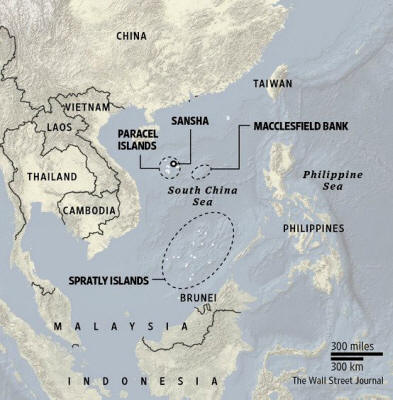
The potentially oil and mineral-rich waters,
which are also home to key
international trade routes,
are claimed in whole by PRC
China and in part by
ROC Taipei, Vietnam, the
Philippines, Malaysia and Brunei.
The completion of the Pentagon
"String of Pearls" hangman's noose around
China to cut off vital energy and other imports in event of war by 2012 was
centered around the increased U.S. manipulation of events in the South China
Sea.
The Ministry of Geological Resources and Mining
of the People's Republic of China estimated that the South China Sea may
contain 18 billion tons of crude oil (compared to Kuwait with 13 billion
tons).
The most optimistic estimate suggested that potential oil resources
(not proved reserves) of the Spratly and Paracel Islands in the South China
Sea could be as high as 105 billion barrels of oil, and that the total for
the South China Sea could be as high as 213 billion barrels. [31]
The presence of such vast energy reserves has not surprisingly become a
major energy security issue for China.
Washington has made a calculated intervention in
the past several years to sabotage those Chinese interests, using especially
Vietnam as a wedge against Chinese oil exploration there. In July 2012 the
National Assembly of Vietnam passed a law demarcating Vietnamese sea borders
to include the Spratly and Paracel islands. U.S. influence in Vietnam since
the country opened to economic liberalization has become decisive.
In 2011 the
U.S. military began cooperation with Vietnam, including joint
"peaceful" military exercises. Washington has backed both The Philippines
and Vietnam in their territorial claims over Chinese-claimed territories in
the South China Sea, emboldening those small countries not to seek a
diplomatic resolution. [32]
In 2010 U.S. and UK oil majors entered the bidding for exploration in the
South China Sea. The bid by Chevron and BP added to the presence of U.S.-based
Anadarko Petroleum Corporation in the region.
That move is essential to give Washington the
pretext to "defend U.S. oil interests" in the area. [33]
In April 2012, the Philippine warship Gregorio del Pilar was involved in a
standoff with two Chinese surveillance vessels in the Scarborough Shoal, an
area claimed by both nations. The Philippine navy had been trying to arrest
Chinese fishermen who were allegedly taking government-protected marine
species from the area, but the surveillance boats prevented them.
On April 14, 2012, U.S. and the Philippines held
their yearly exercises in Palawan, Philippines.
On May 7, 2012, Chinese Vice Foreign Minister
Fu
Ying called a meeting with Alex Chua, Charge D'affaires of the Philippine
Embassy in China, to make a serious representation over the incident at the
Scarborough Shoal.
From South Korea to Philippines to Vietnam, the Pentagon and
U.S. State
Department is fanning the clash over rights to the South China Sea to
stealthily insert U.S. military presence there to "defend" Vietnamese,
Japanese, Korean or Philippine interests. The military hangman's noose
around China is being slowly drawn tighter.
While China's access to vast resources of offshore conventional oil and gas
were being restricted, Washington was actively trying to lure China into
massive pursuit of exploitation of shale gas inside China.
The reasons had nothing to do with U.S.
goodwill
towards China.
It was in fact another major weapon in the destruction of
China, now through a form of environmental warfare.
Notes
-
Halford J. Mackinder,
The Geographical Pivot of History, London, Royal Geographic
Society, 1904. Mackinder's Pivot Area was what later essentially
became the Soviet Union, including Central Asia, plus
Afghanistan.
-
President Barack Obama,
"Remarks By President Obama to the Australian Parliament",
The White House Press Office, November 17, 2011.
-
Ibid.
-
Otto Kreisher,
"UK Defense Chief to NATO: Pull Your Weight in Europe While
U.S.
Handles China", AolDefense, July 22, 2012.
-
BBC,
China military
'closing key gaps', says Pentagon", 25 August
2011.
-
Ibid.
-
Greg Jaffe, "U.S.
Model for a Future War Fans Tensions with China and inside
Pentagon", Washington Post, August 2, 2012.
-
Ibid.
-
Matt Siegel, "As
Part of Pact, U.S. Marines Arrive in Australia, in China's
Strategic Backyard", The New York Times, April 4,
2012.
-
Greg Jaffe,
op. cit.
-
F. William Engdahl, Full Spectrum Dominance: Totalitarian
democracy in the New World Order, Wiesbaden, 2009,
edition.engdahl, p. 190.
-
The Washington Times, "China
Builds up Strategic Sea Lanes", January 17, 2005.
-
Ibid.
-
Ibid.
-
Wall Street Journal, "An
Opening in Burma: The regime's tentative liberalization is worth
testing for sincerity", November 22, 2011.
-
Radio Free Asia, "U.S.
to Invest in Burma's Oil", 7 November, 2011.
-
Shaun Tandon, "U.S.
eases Myanmar restrictions for NGOs", AFP, April 17,
2012.
-
Craig Whitlock, "U.S.
eyes return to some Southeast Asia military bases", Washington Post, June 23, 2012.
-
Ibid.
-
Ibid.
-
Premvir Das, "Taking
U.S.-India defence links to the next level", Rediff News,
June 18, 2012.
-
Zeenews, "U.S.-India
ties are global in scope: Pentagon", August 02, 2012.
-
Ibid.
-
Gregoire Lalieu, Michel Collon, "Is
the Fate of the World Being Decided Today in the Indian Ocean?",
michelcollon.info, November 3, 2010.
-
Zbigniew Brzezinski,
The Grand Chessboard: American Primacy And It's Geostrategic
Imperatives, 1997, Basic Books, p. xiv.
-
Ibid.
-
Ibid.
-
Cas Group, "Background
on the South China Sea Crisis", pdf.
-
Gregoire Lalieu, et al, op. cit.
-
Ibid.
-
GlobalSecurity.org, "South
China Sea Oil and Natural Gas".
-
Agence France Presse, "U.S.,
Vietnam Start Military Relationship", August 1, 2011.
-
Zacks Equity Research, "Oil
Majors Eye South China Sea", June 24, 2010.
|











